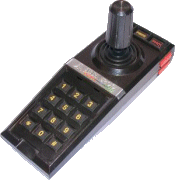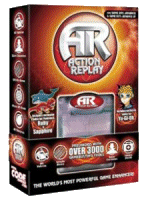The Best Innovations That Went
Into Games
And Game Systems
When people think of innovations in the area
of videogames and game systems, they may think in terms of technology like the
game storage format going from cartridges to compact disks to DVD-ROMs, or going
from flat 2D "sprite" images to 3D-polygonal characters and playfields.
Admittedly, these are noteworthy innovations that have allowed game designers
more freedom to create games that fully realize their vision. However, not
all the best innovations come in the most obvious of packages. In fact,
some of them have managed to sneak in when we least expected and made themselves
at home in our game systems. This article will cover what I think are the
best innovations that have come along over the years that rank as significant as
the advances in home gaming technology:
 1. Pause buttons -- Playing a
videogame can be so involving to where a single distraction can throw a
player's concentration out of whack, resulting in some onscreen damage or the
loss of a gaming life. Whether it's the telephone that needs to be
picked up, or being called to the dinner table, or having to leave the game in
order to go to the bathroom for immediate relief, or whatever else, these
distractions may force the player to abandon the game in progress in order to
deal with them. While it's probably not a very big innovation, the pause
button does allow for players to keep their current game going, stopping in
midgame and then picking it back up at any time. The Mattel
Intellivision system had a built-in pause feature that required the player to
press two keypad buttons (1 and 9) together in order to activate it, blanking
out the screen in the process, with only the press of a button or the control
disc to reactivate play. The Atari 5200 had a pause button right on the
controller itself, while the Atari 7800 and Sega Master System put theirs
right on the console, making it less convenient for players to just stop their
game in midplay. Fortunately, Nintendo made the controller's Start
button that also acted as a pause button a common feature on videogame systems
from the NES onward.
1. Pause buttons -- Playing a
videogame can be so involving to where a single distraction can throw a
player's concentration out of whack, resulting in some onscreen damage or the
loss of a gaming life. Whether it's the telephone that needs to be
picked up, or being called to the dinner table, or having to leave the game in
order to go to the bathroom for immediate relief, or whatever else, these
distractions may force the player to abandon the game in progress in order to
deal with them. While it's probably not a very big innovation, the pause
button does allow for players to keep their current game going, stopping in
midgame and then picking it back up at any time. The Mattel
Intellivision system had a built-in pause feature that required the player to
press two keypad buttons (1 and 9) together in order to activate it, blanking
out the screen in the process, with only the press of a button or the control
disc to reactivate play. The Atari 5200 had a pause button right on the
controller itself, while the Atari 7800 and Sega Master System put theirs
right on the console, making it less convenient for players to just stop their
game in midplay. Fortunately, Nintendo made the controller's Start
button that also acted as a pause button a common feature on videogame systems
from the NES onward.
2. Game saving -- As games became
increasingly longer and more complex, another innovation came along to help
keep players' interest in finishing the game they're playing and to keep
players from going back to the beginning of the game to retread on familiar
territory -- game saving. Originally a feature that appeared on personal
computer games of the early 1980s, it would make its entry onto the videogame
scene with two different methods -- battery-backed file saving and passcode
reentry. The former, which made its debut in 1987's Legend Of Zelda
by Nintendo for the NES, simply just takes all the necessary data of what the
player has accumulated and where he's at in the game and all and just saves it
into memory, where it can be easily retrieved at a later date to pick up the
game where the player left off. The latter form, which is commonly
called "password entry" but I will call "passcode reentry" for the following
reason, just gives the player a code that can be entered that will allow the
player to resume the game where he left off or start a new game on the last
level that he was on. Passcode reentry made its appearance with the 1987
release of Metroid for the NES. At present, though, games that
now do game-saving are mostly using optional memory cards for memory storage
since compact disks do not at present have the ability to store any
information directly on them like cartridges did. The X-Box, however, is
using a built-in hard drive for this purpose, though with the next generation
of systems, Microsoft's successor system might end up using memory cards for
game saving.
 
|
3. Game cheating devices such as
the Game Genie -- This particular innovation, which had its origins in the
game systems of the early 1980s with Answer Software's Personal Game
Programmer device for the Atari 2600, has both proponents and opponents of
such devices being made available. Those who favor the likes of Game
Genie, Game Shark, and Action Replay say that they help weaker players enjoy
the games that would otherwise defeat them, while those who disfavor them say
they remove the challenge that's part of playing the game. Regardless of
which side of the issue you're on, Nintendo had balked at the idea of the Game
Genie for the original NES being released since they feared lost profits from
games that were rented and beaten overnight by gamers using such devices, and
so for a time ruled against Galoob (the American distributor for Codemasters,
the makers of the Game Genie) in court and stopped them from selling Game
Genies in the United States until a year later, when the court decision was
overturned in Galoob's favor. (Interestingly, the Canadian distributor
of the Game Genie, Camerica, was allowed to manufacture the device across the
border, and some gamers even went so far as to buy Game Genies from Canada.)
While the Game Genie had the shortcoming of having the player input codes
every time the game system gets turned on to play a game, the later-released
Game Shark and pretty much all other game cheating devices in this era have
built-in codes that the player can access for the game he or she wants to
play, and would also allow new codes to be directly downloaded into the device
from their computers. One particular device I owned, the Game Action
Replay for the NES, not only allowed for game saves for games that didn't have
game-saving but also would allow for games to be slowed down to more
manageable speeds for players who could not handle playing them at regular
speeds.
 4. Online gaming devices --
Originally online gaming was solely in the domain of personal computers using
acoustic modems that ran much slower than today's high-speed Internet
counterparts, but the seeds for such use with videogame systems were laid with
the CVC Gameline modem for the Atari 2600 where, at the very least, gamers
could download various games to play on their home console. Direct
online gaming with another person, however, would wait until the mid-1990s
with Catapult Entertainment bringing forth the X-Band modem for the Super NES
and Genesis systems, allowing players of those systems to compete against each
other on Doom, Mortal Kombat II, Super Mario Kart,
Super Street Fighter II, and some of Electronic Arts' annually-released
sports games. The short-lived Sega Dreamcast system would feature a
built-in 56K-speed modem that would allow not only for online gaming with
other Dreamcast owners, but also for emailing and doing websurfing.
Right now, the three major game systems on the market -- the X-Box, the
Gamecube, and the Playstation 2 -- use optional modem accessories for games
specially designed for online playing. And if Infinium Labs'
intended-for-public-release Phantom game system has its way, gamers may end up
buying and downloading games directly online onto their game systems,
eliminating the use of compact disks and DVD-ROMs.
4. Online gaming devices --
Originally online gaming was solely in the domain of personal computers using
acoustic modems that ran much slower than today's high-speed Internet
counterparts, but the seeds for such use with videogame systems were laid with
the CVC Gameline modem for the Atari 2600 where, at the very least, gamers
could download various games to play on their home console. Direct
online gaming with another person, however, would wait until the mid-1990s
with Catapult Entertainment bringing forth the X-Band modem for the Super NES
and Genesis systems, allowing players of those systems to compete against each
other on Doom, Mortal Kombat II, Super Mario Kart,
Super Street Fighter II, and some of Electronic Arts' annually-released
sports games. The short-lived Sega Dreamcast system would feature a
built-in 56K-speed modem that would allow not only for online gaming with
other Dreamcast owners, but also for emailing and doing websurfing.
Right now, the three major game systems on the market -- the X-Box, the
Gamecube, and the Playstation 2 -- use optional modem accessories for games
specially designed for online playing. And if Infinium Labs'
intended-for-public-release Phantom game system has its way, gamers may end up
buying and downloading games directly online onto their game systems,
eliminating the use of compact disks and DVD-ROMs.
 1. Pause buttons -- Playing a
videogame can be so involving to where a single distraction can throw a
player's concentration out of whack, resulting in some onscreen damage or the
loss of a gaming life. Whether it's the telephone that needs to be
picked up, or being called to the dinner table, or having to leave the game in
order to go to the bathroom for immediate relief, or whatever else, these
distractions may force the player to abandon the game in progress in order to
deal with them. While it's probably not a very big innovation, the pause
button does allow for players to keep their current game going, stopping in
midgame and then picking it back up at any time. The Mattel
Intellivision system had a built-in pause feature that required the player to
press two keypad buttons (1 and 9) together in order to activate it, blanking
out the screen in the process, with only the press of a button or the control
disc to reactivate play. The Atari 5200 had a pause button right on the
controller itself, while the Atari 7800 and Sega Master System put theirs
right on the console, making it less convenient for players to just stop their
game in midplay. Fortunately, Nintendo made the controller's Start
button that also acted as a pause button a common feature on videogame systems
from the NES onward.
1. Pause buttons -- Playing a
videogame can be so involving to where a single distraction can throw a
player's concentration out of whack, resulting in some onscreen damage or the
loss of a gaming life. Whether it's the telephone that needs to be
picked up, or being called to the dinner table, or having to leave the game in
order to go to the bathroom for immediate relief, or whatever else, these
distractions may force the player to abandon the game in progress in order to
deal with them. While it's probably not a very big innovation, the pause
button does allow for players to keep their current game going, stopping in
midgame and then picking it back up at any time. The Mattel
Intellivision system had a built-in pause feature that required the player to
press two keypad buttons (1 and 9) together in order to activate it, blanking
out the screen in the process, with only the press of a button or the control
disc to reactivate play. The Atari 5200 had a pause button right on the
controller itself, while the Atari 7800 and Sega Master System put theirs
right on the console, making it less convenient for players to just stop their
game in midplay. Fortunately, Nintendo made the controller's Start
button that also acted as a pause button a common feature on videogame systems
from the NES onward.

 4. Online gaming devices --
Originally online gaming was solely in the domain of personal computers using
acoustic modems that ran much slower than today's high-speed Internet
counterparts, but the seeds for such use with videogame systems were laid with
the CVC Gameline modem for the Atari 2600 where, at the very least, gamers
could download various games to play on their home console. Direct
online gaming with another person, however, would wait until the mid-1990s
with Catapult Entertainment bringing forth the X-Band modem for the Super NES
and Genesis systems, allowing players of those systems to compete against each
other on Doom, Mortal Kombat II, Super Mario Kart,
Super Street Fighter II, and some of Electronic Arts' annually-released
sports games. The short-lived Sega Dreamcast system would feature a
built-in 56K-speed modem that would allow not only for online gaming with
other Dreamcast owners, but also for emailing and doing websurfing.
Right now, the three major game systems on the market -- the X-Box, the
Gamecube, and the Playstation 2 -- use optional modem accessories for games
specially designed for online playing. And if Infinium Labs'
intended-for-public-release Phantom game system has its way, gamers may end up
buying and downloading games directly online onto their game systems,
eliminating the use of compact disks and DVD-ROMs.
4. Online gaming devices --
Originally online gaming was solely in the domain of personal computers using
acoustic modems that ran much slower than today's high-speed Internet
counterparts, but the seeds for such use with videogame systems were laid with
the CVC Gameline modem for the Atari 2600 where, at the very least, gamers
could download various games to play on their home console. Direct
online gaming with another person, however, would wait until the mid-1990s
with Catapult Entertainment bringing forth the X-Band modem for the Super NES
and Genesis systems, allowing players of those systems to compete against each
other on Doom, Mortal Kombat II, Super Mario Kart,
Super Street Fighter II, and some of Electronic Arts' annually-released
sports games. The short-lived Sega Dreamcast system would feature a
built-in 56K-speed modem that would allow not only for online gaming with
other Dreamcast owners, but also for emailing and doing websurfing.
Right now, the three major game systems on the market -- the X-Box, the
Gamecube, and the Playstation 2 -- use optional modem accessories for games
specially designed for online playing. And if Infinium Labs'
intended-for-public-release Phantom game system has its way, gamers may end up
buying and downloading games directly online onto their game systems,
eliminating the use of compact disks and DVD-ROMs.